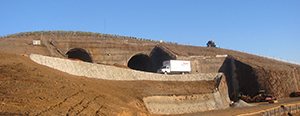Category
- Concrete Waterproofing

Their approach of meticulous stewardship of ancient tradition has led them to the challenge of treating a large-scale vineyard with the intimate wine-making style practiced a smaller operation. Clos de la Tech thus began to operate three separate California vineyards to produce their highly limited Pinot Noirs.

Though a difficult wine-makers feat, the challenges are worth the effort – the soil, called Sweeny Stony Clay Loam, is deep, loamy clay atop a subsoil of very fractured rock, creating superb drainage with a soil pH of 6.5. These ideal soil conditions, combined with the Californian summers of cool nights and warm days, with a powerful marine influence, is a Pinot Noir paradise.

Each of these caves were constructed 30 feet high, 30 feet wide, and 300 feet deep. The top cave contains a total of 56 fermenters, each one capable of making eight barrels of wine, which translates to ten unique bottle bins per fermenter in the bottling cave. The entire process takes approximately four years from grape to bottle.
The caves, like any tunnel structure, can be subjected to temperature changes, corrosion damage and freeze-thaw cycles which affect the structures durability. Proper waterproofing prevents the penetration of moisture and chemicals into the concrete and reinforcing components, ultimately protecting the durability and structural integrity of the concrete; overall, prolonging the life of the cave or tunnel. Kryton’s Concrete Waterproofing System was used to waterproof the wine caves, because a traditional membrane system would not work with the shotcrete application.
When using shotcrete, it is likely that there will be much less uniformity of coverage across a traditional waterproofing membrane, than with other concrete installation methods. The structural bond that must occur between the traditional stick-on waterproofing membrane can be reduced because of overspray from the shocrete. For these reasons, the project’s Architect and Contractor, Drill Tech Drilling & Shoring, turned to Hill Brothers Chemical company for a waterproofing solution. Hill Brothers distributes Kryton International Inc’s line of crystalline waterproofing products, and recommended Kryton’s Krystol Internal Membrane (KIM) to be added directly to the shotcrete itself.
Kryton’s Krystol Internal Membrane (KIM) concrete waterproofing admixture was added directly to the shotcrete mix to create the 45-60 cm (18-24 in.) thick walls that formed the huge wine caves. Krystol Internal Membrane or KIM is an integral crystalline concrete waterproofing admixture; and a PRAH (Permeability Reducing Admixture – Hydrostatic Conditions as referenced in ACI 212.3R-10). When combined with water, KIM’s proprietary chemicals react to form millions of needle-like crystals. These crystals grow and fill the capillary pores and micro-cracks in the concrete, blocking the flow of water. As time passes and stresses form new cracks, any incoming moisture causes the crystals to reactivate – ensuring continuous waterproofing for the life of the concrete structure. Permanent and reliable waterproofing was essential at the Clos de la Tech Winery, as the vineyard and irrigation was only 10 meters (30 feet) above the caves where their carefully crafted Pinot Noir’s were being made.
The three caves were carefully dug one meter (four feet) at a time and immediately reinforced with shotcrete to prevent cave-ins. Unfortunately this approach was not successful and there were two cave-ins in the center cave during construction. The cave-ins vented all the way to the surface and tore two nine meter (30 feet) in diameter holes in the vineyard. Kryton’s KIM was used as an injection-fill system to fill the two holes caused by the cave-ins.
In all, more than 2000 cubic yards of shotcrete were treated with KIM. The project also used Kryton’s Krystol T1 & T2 Surface-Applied System for the office areas within the tunnels. As a surface-applied treatment for new and existing concrete, Krystol T1 and T2 grow crystals deep into concrete, and outperform direct competitors for waterproofing properties in independent side-by-side tests. The concrete itself becomes the waterproof layer and the surface treatment is not required to remain intact for the system to be effective.
Whether using cast-in-place, shotcrete and/or precast concrete for tunnel construction, Krystol Internal Membrane or KIM can be added to the concrete at the plant, or on-site to the mixer truck to make your concrete watertight. This admixture turns the concrete itself into the waterproofing membrane – eliminating the need for any traditional external membrane to be applied. KIM and the Krystol Waterproofing System reduce labor, construction schedules and costs for concrete waterproofing. KIM also works to reduce shrinkage and cracking during the curing process. Kryton’s Krystol concrete waterproofing system also protects the structural rebar from corrosion and provides a durable, leak-free solution for new or existing tunnel construction.
The caves were each built for a different purpose, and work together as one system. Built at different heights, the caves used the force of gravity to allow the wine to flow from one cave to another. The natural winemaking process begins with the top cave capturing the hand-picked grapes directly into the tanks from a sorting pad, through a stainless steel chute. There, the grapes are foot-crushed and native-yeast fermented, before being siphoned by gravity to brand new Francois Freres barrels in the barrel cave. After eighteen months of barrel fermentation, the wine is siphoned from these barrels to a gravity-fed bottling machine in the bottling cave.
The wines from the cave manufacturing process at Clos de la Tech’s Domaine Lois Louise vineyard are set to be available for sale in 2016.



